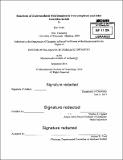Reactions of S-nitrosothiols with biomimetic iron complexes and other transition metals
Author(s)
Victor, Eric, Ph. D. Massachusetts Institute of Technology
DownloadFull printable version (41.66Mb)
Other Contributors
Massachusetts Institute of Technology. Department of Chemistry.
Advisor
Stephen J. Lippard.
Terms of use
Metadata
Show full item recordAbstract
Chapter 1. Bioinorganic Chemistry of Nitric Oxide and S-Nitrosothiols The interplay of nitric oxide (NO), biological thiols, and metals has been a topic of intense study since the discovery of NO as the endothelium-derived relaxation factor. NO is a redox-active diatomic, radical gas that is generated biologically during the conversion of L-arginine to L-citrulline by nitric oxide synthases (NOS), NADH, and 02. NOS enzymes have ironporphyrin and biopterin cofactors that catalyze this conversion. S-nitrosothiols form in biology as NO-transport mechanisms, post-translational modifications, or as a cellular protectant against overexposure to NO. Heme and non-heme iron cofactors serve as targets in biology to induce degradation of active sites or to induce conformational changes to inhibit or promote cellular pathways. The only structurally characterized metal complexes containing S-nitrosothiols have either iridium or ruthenium centers. Chapter 2. Rapid Nitric Oxide and Nitrogen Dioxide Detection and Quantification Assays and Devices based on M(BIPhMe)X₂ Complexes To explore the release of nitrogen oxide gases from reaction solutions, we developed a series of colorimetric sensors based on the cis-nitrogen donating ligand BIPhMe, bis-(1-methylimidazol-2-yl)phenylmethoxymethane. The complexes M(BIPhMe)X₂, where M is Fe²+ or Co²+ and X is Cl~, Br, or I, were prepared, and structurally and spectroscopically characterized. The reactivity of these complexes toward NO (g) and NO₂ (g) in solution was explored and characterized. These complexes were then incorporated into test strips and syringes to provide devices that can qualitatively, and in the case of the syringes quantitatively, detect NO(g) and NO₂(g) in a reaction headspace without additional equipment. Chapter 3. Reactions of (PPN)(SNO) and (PPN)(SSNO) with HBF₄ and Biomimetic Iron Complexes. The biological relevance of HSNO as a transnitrosating was recently reported. The gas H₂S can perform an H+-NO+ exchange with an S-nitrosated serum albumin to form HSNO, which can cross the cellular membrane and transnitrosate an exposed cysteine on a hemoglobin protein. With this discovery, we explored the reactivity of the anion SNO- and the related SSNO- toward an acid and the biomimetic iron complexes [FeIII(TPP)Cl], [Fe₂S₂(SPh)₄]²-, [Fe₂(Et-HPTB)(PhCO₂)]2+, [Fe₂([mu]-OH)(Ph₄DBA)(TMEDA)₂(OTf)], and [Fe(BIPhMe)Cl₂]. In all cases HSNO was found to be unstable. The reaction of SNO with HBF4 led to NO (g) release. The reaction of both S-nitrosothiols with [FeIIITPP)Cl] resulted in reductive nitrosylation of the iron center. The reaction of the [2Fe-2S] cluster with both S-nitrosothiols led to the formation of reduced Roussin's black anion. The reaction of the mononuclear complex [Fe(BLPhMe)C1₂] with both S-nitrosothiols led to formation of the dinitrosyl iron complex [FeS₅(NO)₂]-. Only with the two diiron complexes was a difference in reactivity between SNO and SSNO- observed, leading to formation of Roussin's black anion or [FeS₅(NO)₂]-, respectively. Chapter 4. Reactions of Nitrogen Oxide Species with a Monofunctional Platinum Complex The structural isomers SNO- and NSO- have both been synthetically prepared, but only the metal-binding reactivity of NSO has been previously explored. Structural characterization of early first-row, and second and third row transition metals are reported with NSO-, where metal-binding occurs via the terminal nitrogen atom. We attempted to form structurally characterizable Pt-SNO and Pt-SSNO complexes using the "monofunctional" complex cis-[Pt(NH₃)₂(py)Cl](OTf), but were not successful. Instead, a new complex formed that we propose to be a polysulfide-bridged diplatinum complex with intact nitrogen-binding of the starting complex and release of NO (g). The vibrational spectra of the proposed complexes were calculated using DFT methods to compare with the experimental data and provides further evidence for the formation of a polysulfide-bridged diplatinum complex. DFT calculations were also performed on possible structural isomers of Pt-SNO and Pt-SSNO complexes. To test whether that the reactivity may not occur by release of NO+ from the S-nitrosothiols, cis-[Pt(NH3)2(py)Cl](OTf) was found to react with NOBF4 to form cis-[Pt(NH₃)₂(py)(CH3CN)]2+ and cis-mer-[Pt(NH₃)₂(py)Cl₃]+. Chapter 5. Synthesis of [3:1] Site-Differentiated [4Fe-4S] Clusters and their Reactivity towards NO (g) and Ph₃CSNO Previous studies provide evidence that [4Fe-4S] clusters serve as targets of reactive nitrogen oxide species in biology. The products of this reaction range from dinitrosyl iron complexes, [Fe(NO)₂L₂]-, to Roussin's Black Anion, [Fe₄S₃(NO)₇] . To date, the pathways by which these reactions occur have not been fully elucidated. In this study we prepared the site-differentiated complexes [Fe₄S₄(LS₃)L']² - (LS₃ = 1,3,5-tris(4,6-dimethyl-3-mercaptophenylthio)-2,4,6- tris(p-tolylthio)benzene; L' = Cl, SEt, SPh, N₃, 2-SPyr, Tp, S₂CNEt₂) to serve as synthetic models for biological [4Fe-4S] clusters and studied their reactivity toward NO (g) and Ph3CSNO. The products were characterized by X-ray crystallography, mass spectrometry, and IR, EPR, and H NMR spectroscopy. In all cases reported here, the reactions proceed via formation of the S = V2 species [Fe4S4(NO)4 ] , which ultimately converts to EPR-silent [Fe4 S3(NO)7]. Appendix A. M(BIPhMe) Complexes and Reactions with RNOS The synthesis and characterization of the metal-BIPhMe complexes [Fe(BIPhMe)I₂], [Fe(BIPhMe)(MeCN)₂(OTf)₂], [Fe₂([mu]-O)(BIPhMe)₂(NO₃)₄], [Cu(BIPhMe)₂](OTf)₂ [Cu(BIPhMe)₂][CuCl₂], and [Zn₂([mu]-OTf)₂(BIPhMe)₂(OTf)₂] was reported. These complexes were characterized by X-ray diffraction, FTIR, ¹H NMR, and ESI-MS. The reaction of [Zn₂([mu]-OTf)₂(BIPhMe)₂(OTf)₂] with (PPN)(SNO) results in the release of NO (g) and formation of (PPN)(SSNO) and a zinc-sulfide species. The reaction of (PPN)(SSNO) results in the release of NO (g) and a zinc-sulfide species. Appendix B. Mass-Spec and FTIR figures of the Reactions of NO (g) and Ph₃CSNO with [Fe₄S₄(LS₃)L']²-
Description
Thesis: Ph. D. in Inorganic Chemistry, Massachusetts Institute of Technology, Department of Chemistry, 2014. Cataloged from PDF version of thesis. Includes bibliographical references.
Date issued
2014Department
Massachusetts Institute of Technology. Department of ChemistryPublisher
Massachusetts Institute of Technology
Keywords
Chemistry.